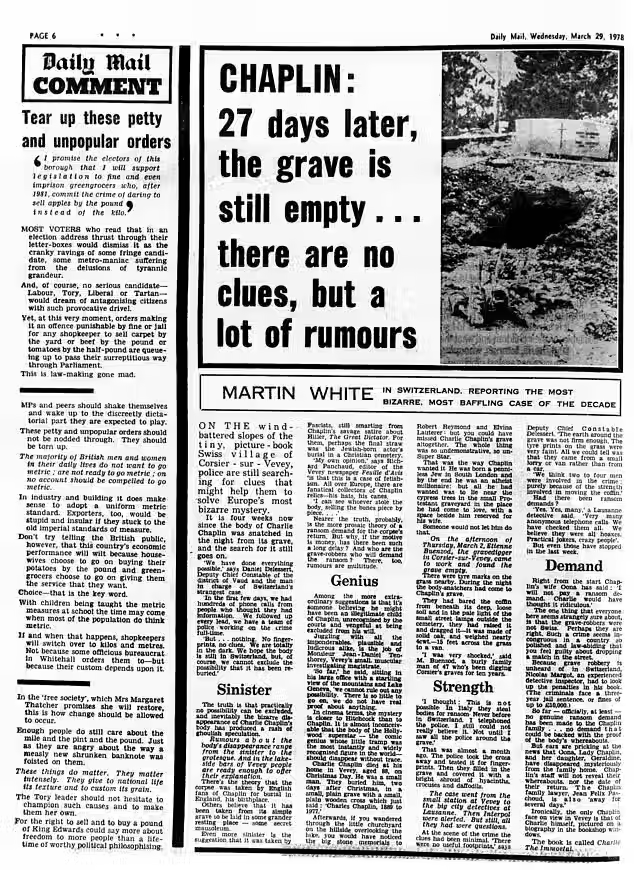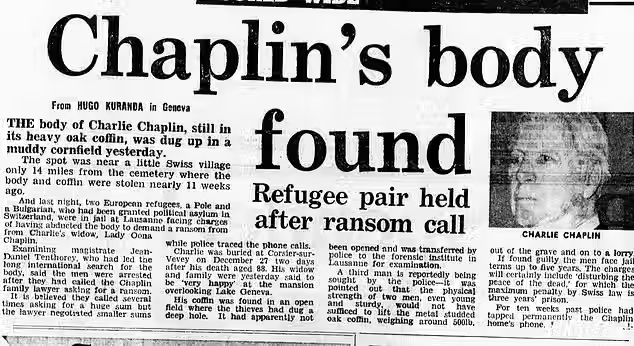That Time Charlie Chaplin’s Body Was Stolen and Held for Ransom
- Daniel Holland

- Mar 2, 2023
- 4 min read

Charlie Chaplin, the eternal Little Tramp, had audiences rolling in the aisles for decades. His physical comedy crossed borders, class lines and languages, leaving the world a little lighter for it. Yet there was nothing remotely amusing about what befell Chaplin’s remains after he bowed out for good. If ever a man could be said to have turned in his grave, it was Chaplin — or rather, two desperate men turned him, quite literally.
A Quiet Life in Switzerland
Having spent much of his career in Hollywood, Chaplin eventually fell out of favour with the United States. His perceived leftist sympathies and scandals surrounding his private life culminated in a revocation of his re-entry permit during a trip abroad in 1952. Rather than fight it, he chose a life of exile in Switzerland, settling into a grand manor on the banks of Lake Geneva in the tranquil village of Corsier-sur-Vevey. There he lived out his remaining years with his wife Oona O’Neill and their children, passing away peacefully on Christmas Day 1977 at the age of 88.
Chaplin’s funeral was a quiet affair, fitting for a man who, despite worldwide fame, sought solitude in his final decades. He was laid to rest in the village cemetery, a stone’s throw from the calm waters of the lake he adored. The cemetery would later become the resting place of other notables, including actor James Mason.

The Body Vanishes
Yet in March 1978, just over two months after the burial, Chaplin’s grave was found gaping and empty. The news sent a ripple of shock through the Swiss village and quickly spread worldwide. Who would dare disturb the peace of such an icon? The answer turned out to be both tragic and farcical.
Chaplin’s widow, Oona, was soon contacted by a man styling himself as “Mr Rochat”. Speaking in halting French, Rochat demanded the equivalent of around $600,000 — a king’s ransom, in exchange for the safe return of Chaplin’s coffin. The plot, clearly inspired by crime fiction and tabloid oddities, was crude but bold.

Unmoved by the threat, Oona refused outright to pay. She told the press later that her husband would have found the whole situation “ridiculous”, and she refused to dignify the criminals’ demands. This steely stance incensed the conspirators, who resorted to threats against Chaplin’s children in an attempt to frighten her into compliance. Again, the family would not bend.

The Net Closes In
With the extortion effort in full swing, Swiss police ramped up a methodical investigation that would have made any detective fiction writer proud. According to Smithsonian Magazine, every one of the region’s 200 public phone booths was staked out by plainclothes officers. Oona’s telephone line was tapped. Decoy calls and fake rendezvous were arranged.
The breakthrough came when a policeman, posing as the family’s chauffeur, negotiated a handover with the criminals. This classic sting led to the arrest of two men: Roman Wardas, aged 24, a Polish refugee struggling to find steady work; and his accomplice, 38-year-old Bulgarian mechanic Gantscho Ganev.

A Misguided Plot Born of Desperation
Wardas admitted in court that he was inspired by a news report he’d read about grave robbers in Italy. Facing destitution in a foreign land, he reasoned that Chaplin’s immense fame might make his remains a lucrative bargaining chip. Enlisting his friend Ganev, the pair dug up the coffin under cover of darkness, loaded it into a battered car, and buried it again in a lonely cornfield near the village of Noville, some 15 miles away.
Under interrogation, Wardas confessed that he never felt squeamish about handling the coffin. “I did not feel particularly squeamish about interfering with a coffin,” he told the court, adding that he had planned to dig a deeper hole but the rain-soaked soil became too heavy to manage.

Their plan, equal parts audacious and incompetent, rapidly unravelled under the watchful eyes of the Swiss police. Both men were found guilty. Wardas, as the ringleader, received a sentence of four and a half years of hard labour. Ganev, seen as a reluctant accomplice, received an 18-month suspended sentence.

Chaplin’s Final Rest, Secured
Once recovered from the cornfield, Charlie Chaplin’s coffin was returned to Corsier-sur-Vevey, this time under far stricter security. The family, no longer trusting that fame alone could protect his grave, had the site reinforced with a thick layer of concrete. Anyone planning to repeat the stunt would need more than a spade and a dark night.
Interestingly, despite the distress and scandal, the Chaplin family forgave the hapless grave robbers. Eugene Chaplin, Charlie’s son, later shared that one of the men’s wives wrote an apologetic letter to Oona. Remarkably, she replied to say all was forgiven and that she bore them no personal grudge. Oona herself died in 1991 and was buried beside her husband, never again disturbed.

From Farce to Film
This strange episode naturally caught the attention of filmmakers. In 2014, director Xavier Beauvois brought the saga to the big screen in The Price of Fame, a warm, gently comedic retelling that used fictionalised names but kept the heart of the real events. The film was made with the blessing of the Chaplin family and serves as a testament to a bizarre moment when the Little Tramp’s final performance was an unwilling part in an absurd criminal plot.
Even in death, Chaplin’s story found a way to blur the line between comedy and tragedy — a fitting encore for cinema’s greatest clown.
Sources:










































































































Comments